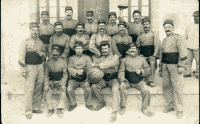Even before studying the image, readers of these little researches into photographs will notice that the uniforms are unusual. This photo card sent by a Territorial in 1915 gives us the opportunity to cross the Mediterranean once again to follow the journey of a mobilised soldier sent to Morocco.

- Casablanca, Morocco
Partly seated on a low wall, these fourteen men, flanked by two corporals, belong to the 128th RIT. This is clearly visible on the collars and kepis of all the uniforms.
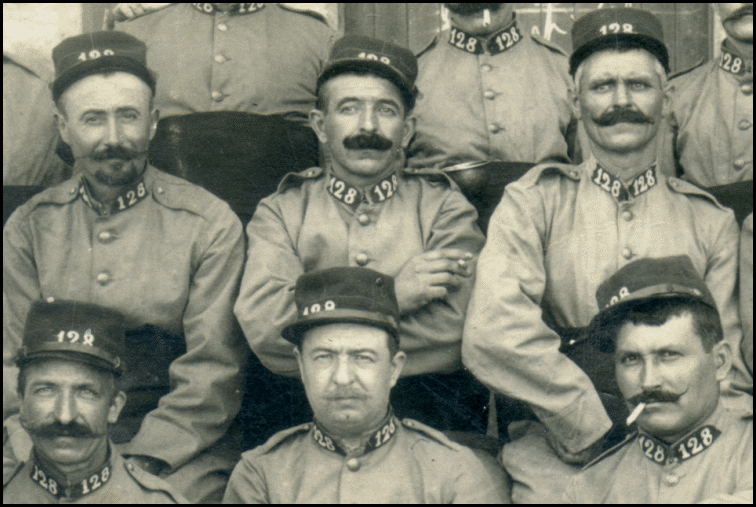
Unlike in metropolitan France, the corporals’ stripes were not sewn onto the sleeves, but rather hung on them, as can be seen clearly.

The uniforms are not the usual colours for a regiment from mainland France. They are simply the uniforms of infantry units in Africa, recognisable, apart from their colour, by the woollen belt worn over the jacket.
Thanks to Marc, from the pages 14/18 forum, these outfits can be identified. He explains: this is the 1901 model light outfit in khaki cotton twill (the jacket can be identified by the shoulder tabs which disappear on later versions). On these jackets, the collar tabs and braids (perhaps also the buttons?) are removable, which is why the braids are held in place by small buttons. Here, each visible braid has a strap to prevent it from drooping.

These men are not on operations. They are not wearing any equipment and some have even slipped on sneakers, the regulation rest shoes.
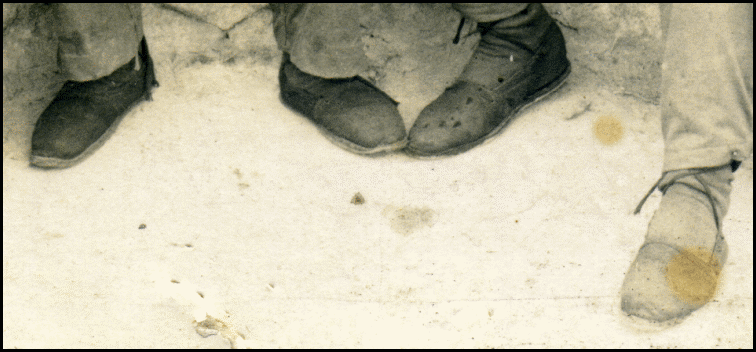
With their kepis conspicuously worn askew, two men took to the stage to honour the wine, perhaps a local one, with the help of a wicker « dame-jeanne ».

Another man has decided to show off by holding a colonial helmet at arm’s length:
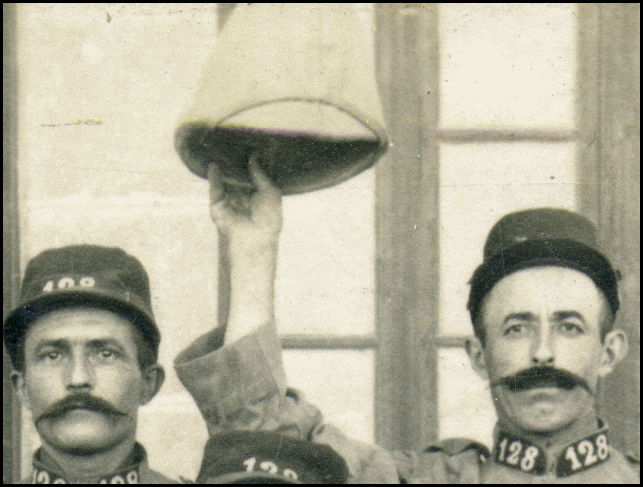
Once again, the photographer’s framing includes three spectator soldiers. Two are visible on the right, one in full and one just by the tip of a shoe. The soldier is also from the 128th RIT but is in exercise or fatigue uniform, a smock and trellis trousers. On the left, not illustrated by a picture, the soldier is more ghostly.
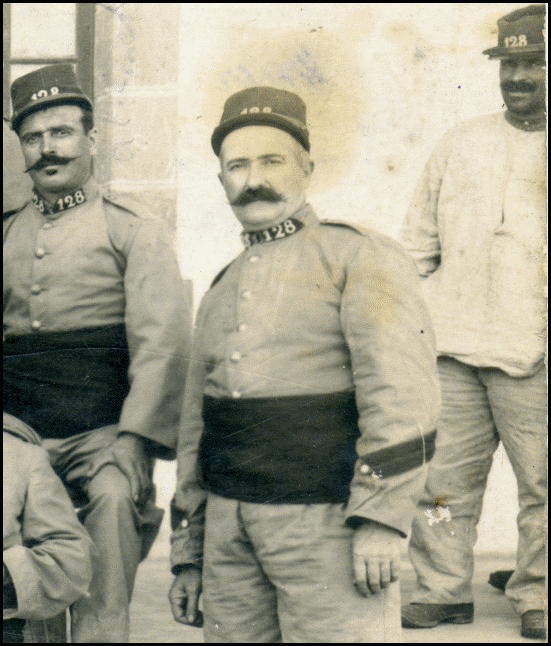
- Who is Henri Terrisse?
There’s no cross in the picture, but there’s an equivalent clue: Henri has written « Terrisse », his name, above his head!
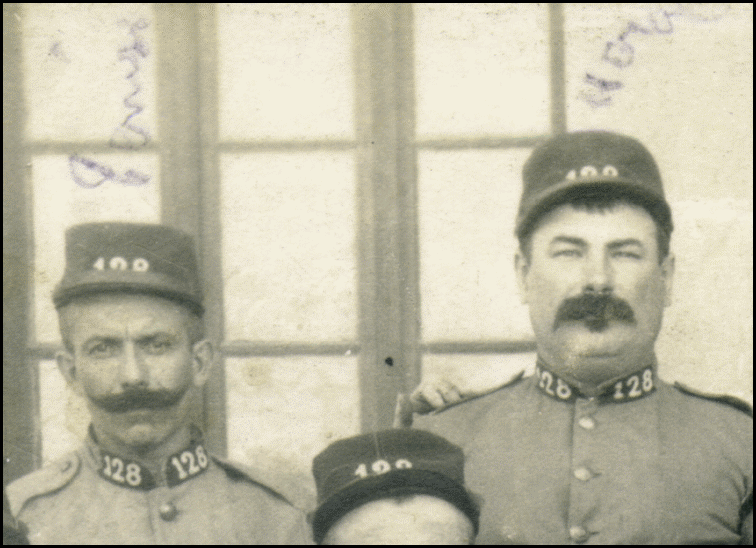
He has added what is probably a name above his neighbour, on whom he has placed his hand. However, the handwriting is illegible, making identification impossible. Especially as his letter only mentions a « Miquel », which is clearly not what is written here.
- Family first
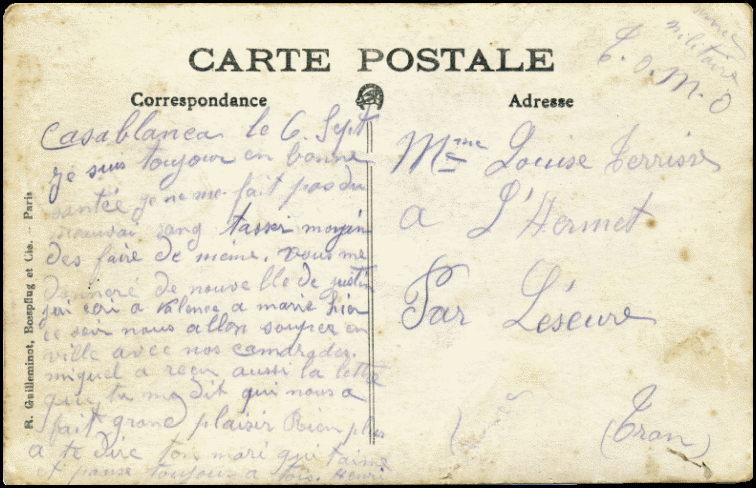
« Casablanca le 6 Sept.
Je suis toujour en bonne santée. Je ne me fait pas du mauvai sang. Tasser (sic) moyin des faire de même. Vous me donneré de nouvelle de justin jai écri a Valence a marie hier. Ce soir nous allon souper en ville avec nos camarades. Miquel a reçu aussi la lettre que tu ma dit qui nous a fait grand plaisir. Rien plus a te dire. Ton mari qui t’aime et panse toujour a tois.
Henri »
With his poor spelling, he wrote to Louise, his wife since 1902. Note the « Tran » for the department in the address. He says absolutely nothing about his military activities. He does, however, mention an outing in town with his comrades. He stays focused on life back home: he asks for news of Justin. Justin is his brother. We can understand why he is so worried. In March 1915, Justin was posted to a fighting unit and sent to the front with the 33rd RIC. He stayed there until he was evacuated due to illness in June. At the beginning of September 1915, when Henri was writing his card, Justin was at the end of his stay in hospital and returned to the depot the following month. He stayed there until his demobilisation.
It is hard to say who he was writing to in Valence. There were many « Marie’s » in the family, starting with Justin’s twin sister. This is probably her, but it could also be Marie Rossignol, Justin’s future wife. They did not marry until 1919, but perhaps they already knew each other?
- Fighting in Morocco?
Let’s come back to Henri. We have very little information about his career during the conflict. He joined the 128th RIT on 4th August 1914 and left on the 14th for Morocco. He stayed there until 13 February 1916, when he was detached to Saut-du-Tarn. He did not put on his uniform again until his demobilisation. For his presence in Morocco, he was awarded the Colonial Medal with Morocco clasp. The documents say nothing more. The photo card adds his presence in Casablanca in September 1915.
Henri’s service record is not very helpful. Although it lists the main stages of his military service, there is nothing to indicate his duties during his stay in Morocco. If the photograph was taken at Henri’s billet, he must have belonged to the 9th Company. Indeed, behind a comrade’s head, a number can be seen written in chalk on a door, which can only be 9, « 9e Cie ».
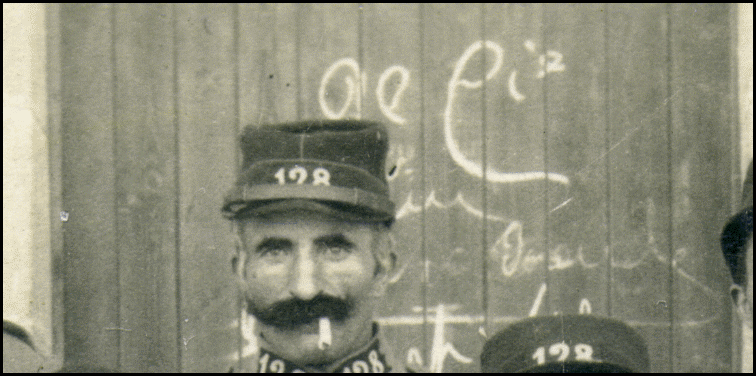
In the absence of digitised resources such as a possible JMO, the history of the 128th RIT may detail the career of each battalion, but it is impossible to trace Henri’s career. The 9th Company was supposed to be stationed at Meknes. Casablanca is never mentioned. We can therefore deduce nothing about his career from this photograph alone and the short text that accompanies it.
The mention of obtaining a veteran’s card on 19 September 1929 is interesting. It is supplemented by a « has no right » followed by « Préfecture advised to withdraw on 30 December 1932 ». How is it possible that a soldier sent to Morocco who stayed there for over a year and a half is not entitled to a veteran’s card? Even if the full text has not yet been found, there must be a link with the circular dated 29 July 1932 listing the territorial infantry units entitled to the veteran’s card. The text of the law of 24 August 1930 was rather imprecise, stating only for troops in Morocco:
« (Morocco.)
Headquarters, intelligence service of the circles, auxiliary offices, troops and services stationed in the second zone and having actually been part of the operational groups ».
The 1932 report was more precise, and not all of the 128th RIT was placed in the same category. Although Henri stayed away from a combat post, guarding prisoners, doing maintenance work and guarding in town, this did not make him a combatant in the sense of the law. Only the table in the 1932 circular or a possible refusal file held by the Departmental Archives can provide any certainty as to the reason for his refusal.
- Conclusion (1)
Using a photograph as a starting point, it was possible to retrace the service person’s career, to make the image speak for itself and to take an interest in another theatre of operations. But there are still many unanswered questions: what was Private Terrisse doing in Casablanca? Why wasn’t he considered a » fighter « ? Who was his neighbour? Here’s hoping there will be a sequel, even for just one of these points!
- Update
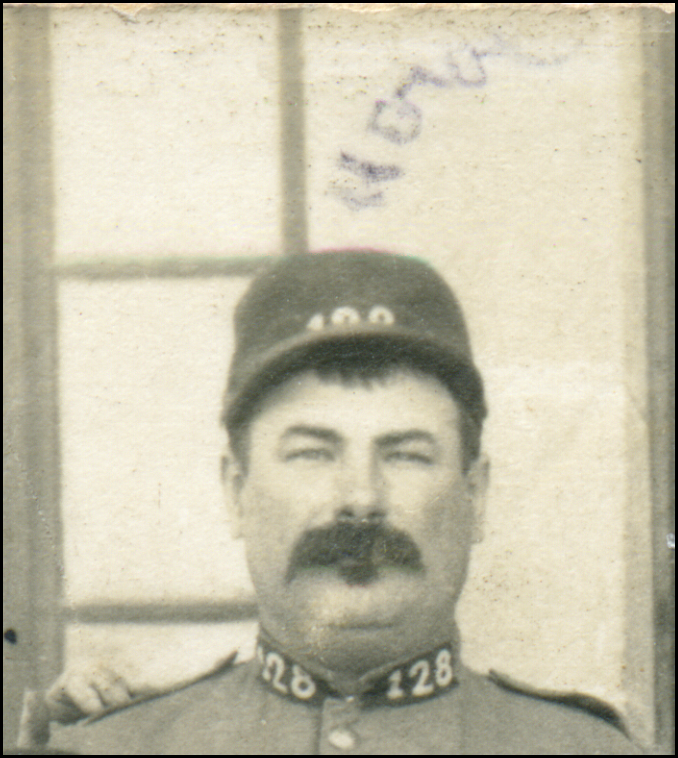
The question still unanswered can be answered: who is the friend annotated on Terrisse’s right? We read « Hera » above his head, bearing in mind that one or more letters may be missing as we reach the worn edge of the image.
Thibaut proposes Gaston Gabriel HERAL, born in Lescure on 7 April 1878. Born in the same village as Terrisse, he was also in the same class as his classmate. What’s more, their paths were perfectly parallel until Terrisse left for Morocco. Héral remained there until 17 February 1919. He also received a veteran’s card in 1930 before it was withdrawn in 1931.
- Conclusion (2)
Two barely legible names, written in graphite on the edge of a photograph, are the tenuous clues that have made it possible to put a face back on the names of two territorials sent to Morocco during the First World War.
- Acknowledgements:
To Thibaut Vallé who managed to find Gabriel Héral
- Sources :
Archives départementales du Tarn :
– 1 R 2100 : Fiche matricule d’Henri Terrisse, classe 1898, matricule 447 au bureau de recrutement d’Albi.
– 1 R 2105 : Fiche matricule d’Elie Justin Terrisse, classe 1898, matricule 482 au bureau de recrutement d’Albi.
– 1 R 2101 : Fiche matricule de Gaston Gabriel Héral, classe 1898, matricule 554 au bureau de recrutement d’Albi.
https://e-archives.tarn.fr/viewer/series/R_serie/1R_Lots/1R2_101?s=1R2_101_0094.jpg&e=1R2_101_0095.jpg&img=1R2_101_0094.jpg
– Etat-civil de la commune de Lescure d’Albigeois, naissances 1873-1878, 4E 144/3
– Etat-civil de la commune de Lescure d’Albigeois, naissances 1879-1882, 4E 144/4
Anonyme, Historique du 128e Régiment d’infanterie territoriale, Auch, imprimerie F. Cocharaux, 1921.
Circulaire du ministre de la Guerre du 29 juillet 1932, concernant les formations de l’infanterie territoriale, dixième recueil, pages 313 à 370.
Gallica : Le texte de loi du 24 août 1930.
